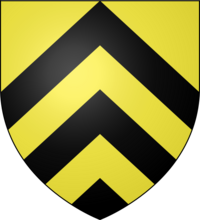County of Hainaut facts for kids
Quick facts for kids
County of Hainaut
|
|||||||||||||
|---|---|---|---|---|---|---|---|---|---|---|---|---|---|
| c. 900/1190–1797 | |||||||||||||
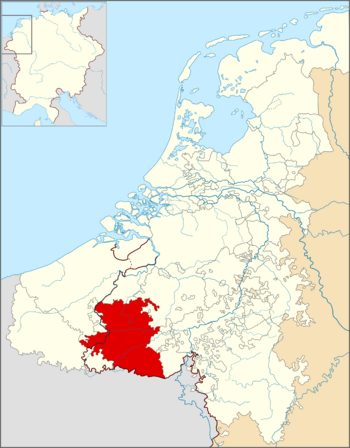 |
|||||||||||||
| Status | County | ||||||||||||
| Capital | Mons | ||||||||||||
| Common languages | |||||||||||||
| Religion | Roman Catholicism | ||||||||||||
| Government | Feudal lordship | ||||||||||||
| Count of Hainaut | |||||||||||||
|
• ?–898
|
Reginar I (first Reginar count) |
||||||||||||
|
• 1071–98
|
Baldwin II | ||||||||||||
|
• 1432–67
|
Philip the Good, Duke of Burgundy | ||||||||||||
| Historical era | Middle Ages | ||||||||||||
|
• Consolidation of county
|
c. 900/1190 | ||||||||||||
|
• Absorbed into
the Habsburg Netherlands |
18 August 1477 |
||||||||||||
|
• Joined the Burgundian Circle
|
1512 | ||||||||||||
|
• Disestablished
|
1797 | ||||||||||||
| 1797 | |||||||||||||
|
|||||||||||||
| Today part of | Belgium France |
||||||||||||
The County of Hainaut was an important area in the Middle Ages. It was a "lordship" or territory within the Holy Roman Empire. This empire was a large group of lands in central Europe. Hainaut was located where Belgium and France are today. Its main towns were Mons (in modern Belgium) and Valenciennes (in modern France).
The county was named after the Haine river. It stretched from the Haine river southeast to the Avesnois region. It also went southwest to the Selle (Scheldt tributary) river. Over time, the Counts of Hainaut also gained control of parts of Brabant and Oosterbant. Today, the original Hainaut area covers parts of the Belgian province of Hainaut. It also includes the eastern part of the French département of Nord.
Hainaut first appeared in records around the 700s. It was a Frankish gau or pagus, which means a district. It included the Roman towns of Famars and Bavay. By the 800s, it was called a county, meaning it had a single count ruling it. After some changes in the 900s, a large, unified county was formed in 1071. This shape lasted for the rest of the Middle Ages.
For most of its history, Hainaut was a border area. It was right next to the Kingdom of France. From 843, Hainaut was part of a "middle kingdom" called Lotharingia. Around 925, Lotharingia became part of the Kingdom of Germany. Hainaut remained an important border region, or "march," during the High Middle Ages. Even though it was part of the Holy Roman Empire, its culture and language were French. It was also part of the Catholic Archdiocese of Reims. Like its neighbors, Brabant and Flanders, Hainaut often got involved in French politics.
The counts of Hainaut often ruled other counties too. This was called a personal union. Here are some examples:
- Hainaut and Flanders: 1067–71 and again 1191–1246
- Hainaut, Holland, and Zeeland: 1299–1356
- Hainaut, Holland, and Zeeland as part of Bavaria-Straubing: 1356–1432
In 1432, Hainaut, Holland, and Zeeland joined other territories in the Low Countries. These lands belonged to the French House of Valois-Burgundy. This new state was called the Burgundian Netherlands. The Habsburg dynasty inherited these lands in the 1470s.
Later, in 1659 and 1678, southern Hainaut became part of France. The northern part stayed with the Habsburg Netherlands. In 1797, during the French Revolutionary Wars, France took over the northern part. This area later became part of Belgium in 1830.
Contents
What was Hainaut like geographically?
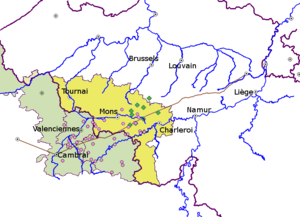
The Haine river, which gave the region its name, flows from east to west. It starts in a forested area near Binche and Charleroi. It then flows into the Scheldt river. From the earliest records, Hainaut also included areas south of the Haine. These areas included the upper Sambre river, the Helpe Majeure, Helpe Mineure, and the Avesnois region.
Hainaut also stretched southwest along the Scheldt river to the Selle river. Here was Famars, an important Roman city. It was a religious and administrative center. Sometimes, old records called parts of Hainaut the pagus Fanomartenis. This might mean Hainaut had another name, or that Famars was the center of a smaller district. A monk from the 900s, Folcuin, said Hainaut was just a new name for the old Roman area.
The old definition of Hainaut stayed pretty much the same for a long time. Archeological finds show that Hainaut, including Avesnes, was an important area for the Belgic Nervii tribe. Their early capital was Bavay in Hainaut, which became a major Roman crossroads.
- To the south of Avesnois, beyond the forests of Thiérache, was the pagus of Laon. This area is now the French department of Aisne.
- To the southwest, the pagus of Cambrai was across the Senne river. Cambrai became the capital of the Nervii and later a bishop's seat. This area is now similar to the French Arrondissement of Cambrai.
- To the west of Valenciennes, across the Scheldt, was the pagus called Osterbant. This area was part of the Atrebates tribe's land in Roman times. Osterbant was often fought over by Flanders and Hainaut.
- To the north, also in the Nervii's old land, was the pagus of Brabant. This area stretched between the Scheldt and Dyle rivers. It included modern Aalst and Brussels. Today, Hainaut reaches into the southern part of old Brabant.
- To the east of the Haine river was the Silva Carbonaria (meaning "charcoal forest"). This forest used to be a big border. Beyond it were regions like Charleroi, Namur, and Leuven.
Where did the name Hainaut come from?
The name Hainaut is believed to come from Germanic words. The first part is the name of the Haine river. The second part, -aut, comes from an old Germanic word meaning "land" or "district." This word is also found in other old Frankish district names. The word "gau," used in the Dutch and German names for Hainaut (Hennegouwen and Hennegau), was also used but not as common in medieval documents for this area.
Early History of Hainaut
The first records that mention Hainaut as a county are from the Carolingian dynasty in the 800s. These records show the empire being divided. Most early medieval records from the 800s describe Hainaut as a pagus (a land or country), not always a county. These early records don't name specific counts who ruled it.
Here are some early mentions:
- 750: A document from Pepin the Short mentions a place in pago Hainoavio.
- 779: A document from Charlemagne mentions a place in pago Haginao.
- 843: The Treaty of Verdun mentions hainaum as a region between the Scheldt and Rhine rivers. It became part of Lothair I's middle kingdom and was likely a county.
- 870: The Treaty of Meerssen mentions the comitatus Hainoum, which means "county of Hainaut." It was given to the western kingdom.
Many old European districts from the Middle Ages have roots in the Roman Empire. As the Roman Empire lost control, these areas came under the rule of Frankish leaders. The Merovingian dynasty and later the Carolingians kept many Roman districts. They appointed counts to manage these pagi.
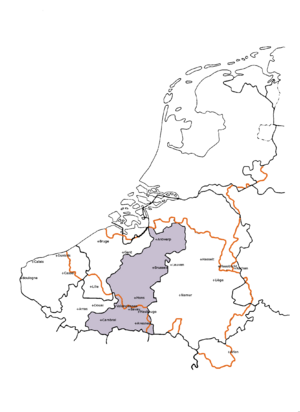
Hainaut in the 900s
It's hard to find clear records of counts ruling all of Hainaut in the 900s. The region is often linked to the Reginarid dynasty. This was a powerful family in Lotharingia. Later, a part of this family took control of the county by force. However, it's not certain if they ruled Hainaut before Reginar III.
The first count clearly linked to a part of Hainaut in a record was Count Sigehard. In 908, he was recorded as a count present at agreements about Lobbes Abbey. This abbey was described as being in the county and pagus of Hainaut.
From 925, Lotharingia, including Hainaut, was part of the eastern kingdom, which became "Germany." In 939, the Reginars led a rebellion against Germany but were defeated. Gilbert, Duke of Lorraine, a son of Reginar I, was killed.
Reginar II (died before 943), another son of Reginar I, was named as a Count of Hainaut in a later story about Gerard of Brogne. His son, Count Reginar III Longneck, might also have been a count in Hainaut. In 958, he rebelled against Duke Bruno the Great and was exiled. It's likely he held Mons, a key town in Hainaut.
After Reginar III was exiled, a Count named Godefrid took over Hainaut in 958. This was likely Godfrey I, Duke of Lower Lorraine. After Godfrey died in 964, Count Richer replaced him. In 973, two noble brothers, Werner and Reynold, were killed near Mons fighting the sons of Reginar III, Reginar IV and Lambert. They had returned to claim their family's lands.
The Reginarid brothers didn't immediately get Hainaut back. Other counts, Godefrid and Arnulf, ruled. They are believed to be Count Godfrey "the captive" and Arnulf of Valenciennes.
Around 998, Reginar IV regained control of the County of Mons in Hainaut. He died in 1013 and his son Reginar V took over. The County of Valenciennes disappeared from records after Arnulf of Valenciennes died around 1011. This part of Hainaut might have been taken over by the County of Flanders.
Hainaut in the High Middle Ages (1000–1250)
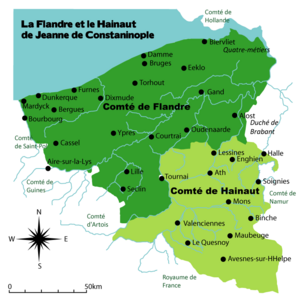
Reginar V married the granddaughter of his father's old rival, Godfrey the "captive." This marriage helped bring peace between the families.
When the last Reginarid Count of Hainaut, Herman, died in 1051 without children, his widow Richilde married Baldwin VI, Count of Flanders. Baldwin VI was a vassal (a noble who held land from a lord) of the French king. When his father died in 1067, Baldwin VI became ruler of both Hainaut and Flanders.
His son, Arnulf III, succeeded him. But Arnulf was killed in 1071 in a fight over his inheritance with his uncle, Robert I the Frisian. Robert won Flanders. However, Richilde kept the lands in the Holy Roman Empire as her dowry (property a wife brings to a marriage).
So, the County of Hainaut was re-established as an Imperial fief (land held under feudal loyalty). This happened after Arnulf's defeat in 1071. Richilde and her son Baldwin II tried to sell their lands to Emperor Henry IV. The Emperor ordered the Prince-Bishop of Liège to buy the lands. Then, the Bishop returned them as a unified county to Countess Richilde and the Dukes of Lower Lorraine.
Even though Baldwin II did not inherit Flanders, he and his descendants were from the same family line as the Counts of Flanders. Eventually, the two lines joined again. Baldwin V married the heiress of Flanders, Margaret, in 1169. He became "Baldwin VIII" of Flanders. During his time, Flanders, Hainaut, and Namur were all ruled by one lord.
In the next generation, Namur went to a different son. Flanders and Hainaut stayed together under Baldwin VI/IX. He became the first emperor of the Latin Empire in Constantinople. Baldwin was killed in Bulgaria. He left two daughters to inherit: Joan and Margaret. Joan ruled but died without children in 1244. Margaret ruled from 1244 and married twice. The families of her two husbands then divided Flanders and Hainaut:
- Jean of Avesnes, Margaret's eldest son from her first marriage, started a new line of Avesnes counts of Hainaut.
- Guy of Dampierre, Margaret's eldest surviving son from her second marriage, started the new line of Flanders counts.
Hainaut in the Late Middle Ages (1250–1500)
From 1299, Hainaut's count, Jean II, d'Avesnes, was also Count of Holland and Zeeland. After his grandson William died in 1347, these same lordships went to his sister. They were then held by members of the Wittelsbach dynasty. This family also ruled the Dukedom of Bavaria-Straubing. This branch of the Wittelsbach family held Hainaut until 1436.
The Wittelsbachs fought among themselves in wars called the Hook and Cod wars. These wars were partly caused by different groups in Holland. After Duke William II of Bavaria-Straubing died in 1417, his daughter Jacqueline inherited Hainaut. But her cousin, Philip the Good, was a powerful opponent.
By 1428, Philip the Good had gained control of Hainaut, Holland, and Zeeland. In 1432, Jacqueline had to give up her rights to these lands to Duke Philip. The last independent countess died in 1436. Her lands became part of the Burgundian Netherlands.
Philip was already Duke of Burgundy and Count of Flanders, Artois, Namur, and Franche-Comte. He later became Duke of Brabant, Limbourg, and Luxembourg. His family, the House of Valois-Burgundy, was a branch of the French royal family. They created a strong state between France and Germany, and Hainaut was part of it.
Charles the Bold of Burgundy, Philip's son, was killed in battle in 1477. This meant the male line of the Burgundian dukes ended. In the same year, Charles' daughter Mary of Burgundy married Archduke Maximilian I of Habsburg. Hainaut then passed to the Habsburg dynasty. This family ruled the Holy Roman Empire and Spain.
King Louis XI of France tried to take advantage of Charles' death. He sent an army to invade the Netherlands. But the French were defeated in 1479. Hainaut was then secured as part of the Habsburg Netherlands by a treaty in 1482.
Hainaut in the Early Modern Period (1500–1800)
Hainaut became part of the Burgundian Circle within the Holy Roman Empire in 1512. It was ruled by the Spanish branch of the Habsburgs from 1555 to 1714.
In 1579, Hainaut joined the Union of Arras. This group agreed to stay under the rule of Habsburg Spain. Meanwhile, the northern provinces formed the Union of Utrecht and rebelled, creating the Dutch Republic in 1581.
Treaties in 1659 and 1679 divided Hainaut into two parts. The southern area, including towns like Valenciennes and Avesnes, was given to France under King Louis XIV. During the French Revolution, this area became the French département of Nord. Today, it is still called French Hainaut.
The northern part of Hainaut, around Mons, remained part of the Spanish Netherlands. After 1713, it became the Austrian Netherlands, moving from one branch of the Habsburgs to another.
In 1797, during the French Revolution, the northern part of the county was given to France. This was done by Emperor Francis II, who was also count of Hainaut. It became the French département of Jemappe. After Napoleon's defeat in 1815, the northern part, again called Hainaut, went to the new Kingdom of the Netherlands. Then, in 1830, it became part of the new country of Belgium. This area forms the basis of the modern Province of Hainaut in Belgium.
Today, you can still see Hainaut's history in its language. The western part of Hainaut is where Picard and Walloon dialects meet.
Images for kids
See also
- Count of Hainaut
- Counts of Hainaut family tree





